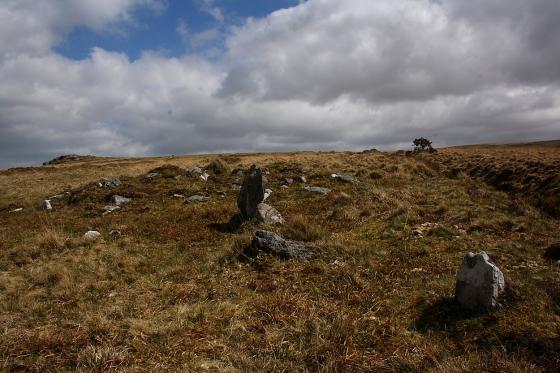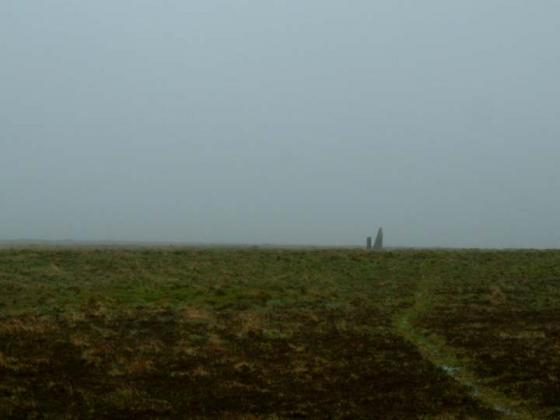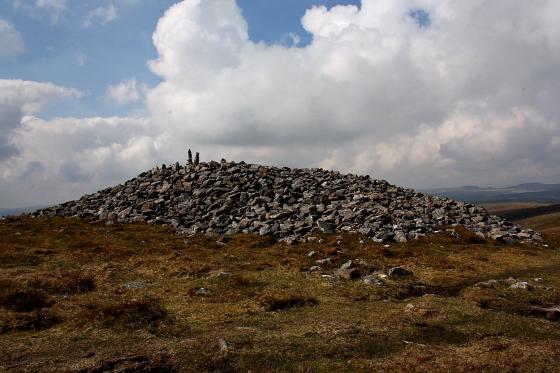
Well, I followed advice and went past the refuge and then back on myself to the corner of the field, jumped the stream and found Yellowmead with dry feet

Well, I followed advice and went past the refuge and then back on myself to the corner of the field, jumped the stream and found Yellowmead with dry feet


Such an interesting circle, trying to work out exactly is going on here

Trying to hide from me!

From ‘A book of the West’ by S Baring-Gould. Volume 1 (1899).


Panorama looking north-west towards Sheepstor.

Hint of a stone avenue going on here on the western side, but it doesn’t go far.

Pan looking south.

A robbed out cairn just south-east of the circles.










Yellowmead flora.

The largest stones, the SE arc of the outer circle.

Looking across the SE arc of the four circles, showing the contrasting size of stones.

Stones of the inner circle.

The perfect central circle.

The SW “avenue”.


The NE cairn circle, looking down the slope to the multiple rings.

Yellowmead circles and Sheeps Tor.


Some of the othostats are surprisingly tall...

This was the most of the solstice sun I saw. 19.6.08


Yellowmeade – December 2003

Yellowmeade December 2003

Sunday 3 July 2005 Approaching roughly from the south, it appeared somebody had beaten us to the circles.... Luckily, I don’t mind horses & Jane loves ‘em

Sunday 3 July 2005 Working around the ponies, we could see the diminutive rows (in the foreground) leading away roughly N from the circles

Sunday 3 July 2005 It becam apparent that the monument was well-guarded as the ponies were reluctant to vacate....

Sunday 3 July 2005 Eventually the ponies moved far enough that we could actually make out the format of the monument. This is looking roughly SW (I think!)

Sunday 3 July 2005 Looking roughly W towards Yellowmead farm

The ponies’ place

The remains of a small cairn just to the north of the circle

Looking towards Sheepstor, Tuesday 10 May 2005
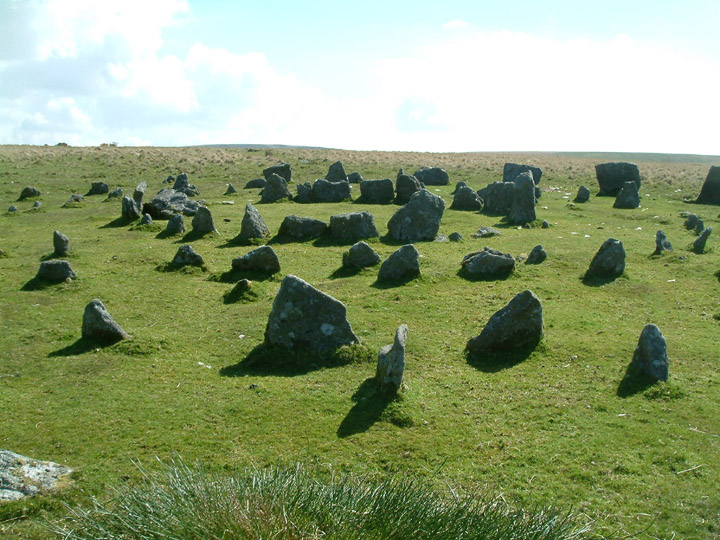
Yellowmead looking East

Yellowmead from another hill.

A little stone circle, south eastwards og the main circles,it is in line with a possible stonerow to the south east

Yellowmead from the direction of sunrise, into the valley
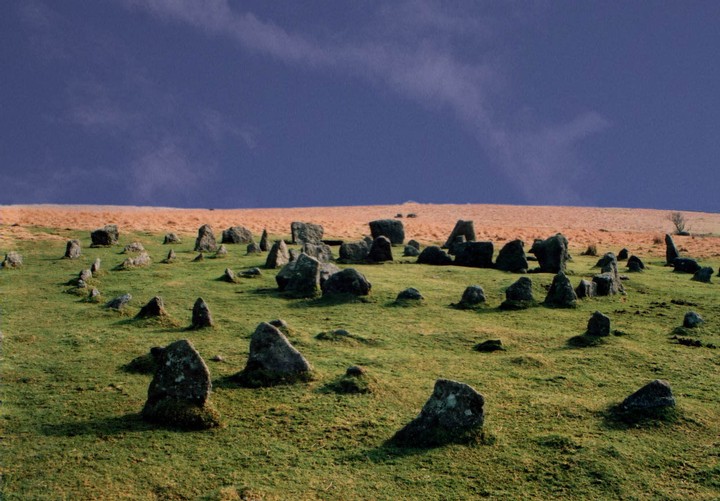

Yellowmead circles on a beautiful February afternoon...

An extremely peaceful place...



A warning to those like myself who have difficulty in interpreting OS maps or are basically a bit thick about following directions. In the heading this site is said to be also known as ‘Piskie House’. On the OS map the name ‘Piskie House’ appears next to Sheepstor itself whereas the circle is described simply as ‘cairn circles’. This misled me into thinking that what I was looking for was right next to Sheepstor despite the contrary visual evidence of the photos posted and what others have said in their fieldnotes. I wasted a good hour fruitlessly searching for it in the wrong place, having walked within about 30 yards of it at one point whilst looking in the opposite direction. I can’t find it being named ‘Piskie House’ in any other book I’ve got. Burl makes it clear that refers to ‘a long narrow cave concealed under a granite overhang’.
Anyway, I found it in the end and can happily echo all that others have said about this site.
The walk from here to the circles is longer than it looks, dropping down into boggier, then muddier, ground. I pass an uninterested group of wild horses, then a rather more nosey herd of cattle, before reaching the circles themselves. I have them to myself, despite the large number of people I can see on Gutter Tor away to the south.
According to Burl, this site was heavily restored in the 1920s by the Rev. Breton. There has been much speculation about it since, including the possibility that it is actually the remains of a round cairn, which would not be out of the question when compared with the construction of the terminal ring cairns at nearby Drizzlecombe. There are a host of features to look at here. Slightly uphill to the ENE, the remains of a much smaller cairn circle overlook the main site. The visible stones of this are small, little more than stumps breaking clear of the cropped grass. In the opposite direction, downhill and the west of the circles, are the remains of a short avenue. A possible continuation extends over the other side of a nearby leat. Again these are small stones, size-wise comparable with the stones of the avenues at Cerrig Duon in South Wales.
The real draw is of course the four circles themselves. Not quite concentric, only two share the same centre and only one (the central) is a true circle. The outermost circle contains the biggest stones, especially to the SE. Even so, none of the stones is over five feet tall and there are a lot of smaller stones in between. The next two rings are comprised of much smaller stones. The central circle is beautifully constructed, the stones virtually touching on the southern arc, making a closed ring surrounding a central space with a diameter a little less than 22 feet. If there was a central cairn, it is gone.
The nearby Tors dominate the landscape of the circles, particularly Sheeps Tor to the NW. The position suggests very strongly that these surrounding features were of paramount importance in the siting of the monument, for it has no extensive views or commanding altitude of its own. Like many of the stone circles of England (West Cornwall and The Peaks, as well as nearby Brisworthy), the presence of a nearby rocky hilltop seems likely to have had significance to the builders.
I spend an hour or so here, watching another band of black rain cloud approach over Sheeps Tor, but passing on its way without delivering its cargo at Yellowmead. It is very peaceful, not a soul comes this way while I’m here. This little site enthralls me. I have no idea whether it is true to its original layout or a restorer’s fantasy. I’m not sure it matters at all. Like Belas Knapp, in my opinion we are richer in having it restored in this way, than we would be if it was left as found in the 1920s.
I parked once more by the scout hut, and started walking that way, when the gate is reached almost double back across the dryest part of the moor, then follow the wall with it on your left, when you can see the farm buildings, head towards Sheepstor (the hill) and the stones are obvious. dry feet at a dartmoor circle how unlikely was that.
All four circles were covered in poo, from several different sources, but the scenery and the lovely little circles more than make up for it.
The central circle is damn near perfect the next two outer circles are made from tiny stones and the outer ring has the biggest stones of all especially on the southern side.
A very photgenic place, but what you really need is to see it from above.
On the way back when the wall stopped, I tried to take the direct route back to the car instead of retracing my steps back to the scout hut, big mistake, I was wet once more. The best route is definatley the right hand route, it is longer but is also drier .
I was looking forward to the madness of Yellowmead. It’s not the easiest to get to though – don’t expect a path and do expect to get your feet wet as you go bog-wading. And you need your megalith-antenna on maximum setting to find it- oh and an OS map, of course. It wasn’t immediately clear where the hell it was, although we knew we were going in the right direction.
Suddenly it dawned on Moth that the large herd of ponies we could see had chosen it as a cool place to hang out. We approached cautiously. Though they looked cute and cuddly we were aware they are wild animals and had some very young foals with them to protect. It became clear that they weren’t going to move for us and we’d just have to work round them. It meant we couldn’t walk among the small stones at all but had to walk round and round to try and get a sense of what was going on between the hoofs, sleeping foals, squabbling stallions and grazing mares. Were there four rings? Was it a cairn? The ponies weren’t saying.
My first site on a walk that would take me to many other historic remains this sunny May day. The circle is small...and too perfect for my liking! Something in my head tells me that this originated as a simple cairn but when the restorers got here they decided to create a stone circle (or 4). I missed the stone row but as i was to see later that would tie in with the cairn thoughts.
It is a nice spot (although the aroma from the recently spread field nearby was a bit off putting) with Sheeps Tor towering over it from the west. To think I sat up there on countless occasions back in the late 80s and never even noticed this site....
Thanks to the directions in Goffik’s fieldnotes, I got here without incident: the sun was shining, and, as I tramped across the moor, Skylarks rose from the ground before me, singing their song, but finding little purchase in the gusting wind that blew cold from the south-east. The long grass was dry, flat and bleached white, but the peat beneath still held it’s generous allotment of water, squelching beneath my Size 12’s as I approached from the east.
The circles themselves, and the little avenue, sit well in the landscape, between the imposing mass of Sheepstor, and the lesser height of Gutter Tor. As the small stone row certainly seems to align through the circle to the smaller five stone circle slightly higher up the slope, and I believe towards a flat (fallen?) stone south-west of the circle (and the small stream) on the slope. One stone of the inner circle is recumbent: perhaps it was too heavy for the restorers of 1921?
It is a peaceful place, worth the twenty-minute tromp from the car park: stay a while and try to figure it out – you’ll find yourself lost in a very simple landscape. A walk around four concentric circles* (all but the outer one complete) allow the visitor to view the moor in different aspects; the impressive grandeur of neighbouring Sheeps Tor, the greener enclosed land of the farm in the valley below, the gently sloping rough grassland that hides the circle from the east, and the distant granite tumble of Leather Tor. A marvellous place to recharge and ponder beneath the blue spring sky.
I walked out via Sheeps Tor, down into the green lushness of the valley beyond the farm; as I came out onto the road leading back to the car, I happened to look up to my left across the valley towards Sheeps Tor. Amazingly, a near-perfect circle of some sixty sheep were formed in a field below the Tor... synchronicity? No, they were being fed by a farmer on a quad bike!
* An interesting entry in Volume 5 of the Dartmoor Atlas of Antiquities (Jeremy Butler, 1997, p186) notes that: “perhaps......multiple rings, such as the free-standing stone circles, represent a faint ancestral echo of those gigantic pillared monuments in stone or wood in Wessex.”
Wow. That’s what I say, anyway! What an absolutely peaceful place this is... only the wind, sheep and birds making any noise. Oh, and the occasional low-flying aircraft! Bloody MOD...
But what a weird one! I knew this was made up of smallish stones, but I was shocked at how small! Some of the stones are weeny, but the whole place feels really powerful... Just so peaceful, calm and relaxing... I will most certainly come back here... and so should you!
Directions: On the A386, come off the big roundabout at Yalverton. There is a row of shops, and a small road leading off behind them towards Meavy. Follow the signposts to Sheepstor until you see a sign for Nattor – head for Nattor – the car park is at the end of the road.
From the car park, the circle is roughly North-West and can be reached in a number of very squidgy, marshy routes: Direct – through the stream – very wet!; From the left – along the fence – still boggy and streamy!; from the right – boggy, soggy, marshy, but probably the driest and there are some discernable paths...
Go on then! Off you go!
Another Dartmoor oddity here! Yellowmead consists of 4, not quite concentric, circles and a short row. The tallest stones lie just South of East with the row slightly West of South.
The stones of the innermost circle form a near continuous wall.
[In the village] we vainly endeavoured to procure a guide to what a good woman we talked with called “Piskie House,” on the side of Sheep’s Tor. Piskie House is a natural fissure, or narrow cavern amongst the rocks, where Elford the royalist [...] was said to take shelter for a considerable time, to avoid the pursuit of Cromwell’s troopers. One little boy told me he was afraid to go there; and his mother truly said “That it was a critical place for children.”
[...] Aloft amidst the most confused masses of rock, that looked as if they had been tossed about by the fiends in battle, in a place which seemed (so it appeared to me at least) as if inaccessible to any mortal creatuer, there was seen a somewhat projecting stone like a pent-house. Beneath was a cleft between two low rocks. This is the entrance to the palace of the Pixies, and the cavern where Elford is said to ahve found a retreat from persecution [...] How Elford could live there; how food could be conveyed to him, or how any living thing but a raven, a crow, or an eagle could make his home in such a spot, is to me, I confess, a puzzle; and had not the paintings on the interior sides of the rocks, executed by Elford, been really seen in these latter days to bear witness to the fact, I should have doubted the tradition altogether.
[... an excerpt from Mr Bray’s diary of 1802] On reaching the little hamlet of Sheepstor, we were informed by the matron of it, whom from her age and appearance we denominated the Septuagenarian Sibyl, that we might easily find out the ‘pixies’ house, where we should be careful to leave a pin, or something of equal value, as an offering to these invisible beings; otherwise they would not fail to torment us in our sleep. After thanking the good dame for her advice and information, we proceeded in search of it. [...] With a little boy for our guide, we again ascended the mountain. Leaving our horses below, we followed our conductor over some rugged rocks, till he came to one in which was a narrow fissure. On telling us this was the entrance we laughed, and said none but the pixies and himself could enter it; but, on his assuring us it was the spot, I resolved to make the attempt. With great difficulty I succeeded, and found a hollow about six feet long, four wide, and five feet high. It was formed by two rocks resting in a slanting position against another in a perpendicular direction. The cavity was certainly singularly regular, and had somewhat the form of a little hovel. A rock served for a seat, and the posture of sitting was the only one in which I could find myself at ease. A noise occasioned by the dripping of water is distinctly heard; and as the cause of it is out of sight, it produces at first a sensation somewhat approaching to surprise, till reflection tells us the occasion of it: which might possibly have prepared the mind to imagine it the resort of invisible beings.
The Rev. Mr. Polwhele, in his Devon, notices it, and in a note gives the following extract from a correspondent. “Here, I am in formed, Elford used to hide himself from the search of Cromwell’s party, to whom he was obnoxious. Hence he could command the whole country; and having some talents for painting, he amused himself with that art on the walls of his cavern, which I have been told (says Mr. Yonge of Puslinch) by an elderly gentleman who had visited this place, was very fresh in his time. The country people have many superstitious notions respecting this hole.” None of the paintings now remain on the sides of the rock.
From p v3 102, 108 and v1 p233-5 of ‘Traditions, legends, superstitions and sketches of Devonshire..’ by Anna Eliza Stothard (Bray), 1838.
Mark Beeson at Dartmoor Resource has some more information on Mr Elford, and you can see a carving said to be by him at the local church.
Dartmoor Cam shows you where it is (complete with infuriating tupperware), and The Faery Folklorist has some nice bright shots of the entrance.
As FourWinds says in the associated forum posts – Yellowmead is surely all about the Tor that overlooks the site: Sheeps Tor (don’t blame me for the lack of apostrophe, blame the OS). And up on Sheeps Tor, naturally, there are pixies.
Amid [the ‘vast clatter of boulders’ on the side on which the village lies] is a narrow opening between two upright rocks, which will admit the visitor, though not without a little difficulty, into a small grotto, celebrated in local legend, and known as the Pixies’ Cave.
On entering the cleft we shall find that the passage, which is only a few feet in length, turns abruptly to the left, and we shall also have to descend a little, as the floor of the cave is several feet lower than the rock at the entrance. This turning leads immediately into the cave which we shall find to be a small square apartment capable of containing several persons, but scarcely high enough to permit us to stand upright. On our left as we enter is a rude stone seat, and in the furthest corner a low narrow passage, extending for some little distance, is discoverable.
According to a note in Polwhele’s Devon, this cavern became the retreat durng the Civil Wars of one of the Elford family, who here successfully hid himself from Cromwell’s soldiers, and it is related that he beguiled the time by painting on the rocky walls of the cavern, traces of the pictures remaining long afterwards, hut nothing of the sort is discoverable now [..]
The cave is rather difficult to find, and one might pass and re-pass the crevice which forms its opening, without ever dreaming that such a place existed there, so narrow does the entrance look. The clatter is a perfect wilderness of boulders, and stretches around to the eastern side of the tor, where the rocks rise perpendicularly, forming a precipice of great height.
As we stand at the entrance to the grotto we may look down upon the little village of Sheepstor and its church with sturdy granite tower, nestling in the sheltered combe, while the grey tor rises high behind us, exposed to all the buffetings of the wild moorland storm.
From chapter 1 of ‘Tales of the Dartmoor Pixies‘
by William Crossing [1890]. Online in full at the Sacred Texts Archive.
sacred-texts.com/neu/eng/tdp/tdp02.htm
The circles were reconstructed from the fallen stones in 1921 – apparently faithfully to their original positions.
There is another fourfold circle at Shovel Down.
A page about Yellowmead on this archive of over 5000 photos of stone circles and other megalithic monuments in the British Isles, Ireland and Europe.
Seven pictures and guide.



















































